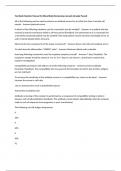Exam (elaborations)
Test Bank Solution Manual for Blood Bank Reviewing concepts Already Passed
- Course
- Institution
Test Bank Solution Manual for Blood Bank Reviewing concepts Already Passed All of the following may be used to perform an antibody screen for an infant less than 4 months old except: - Answers paternal serum In which of the following situations can the crossmatch test be omitted? - Answers in a ...
[Show more]



